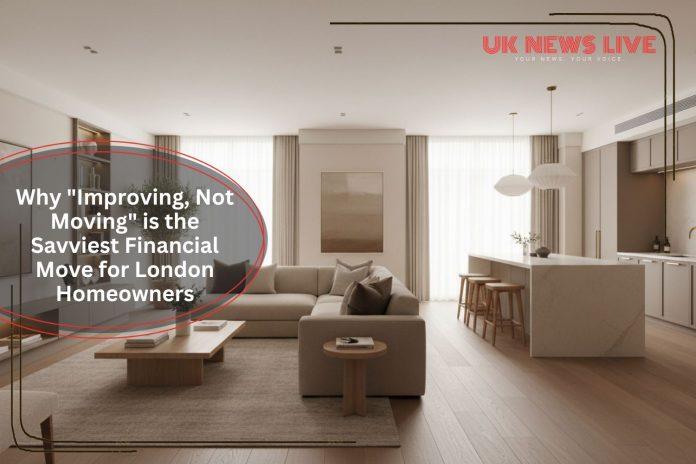For many London homeowners, the familiar story goes like this: the flat that was once a perfect-fit bachelor pad, or the two-bedroom terrace that felt so spacious, is suddenly bursting at the seams. A new baby is on the way, the “temporary” work-from-home desk has become a permanent fixture, and the walls are closing in.
The instinctive solution? Move.
But one glance at the current property market is enough to induce paralysis. Locked in by a combination of stubbornly high house prices and mortgage rates that have settled at a “new normal” high, the cost of upsizing is eye-watering.
Then there’s the issue of stagnant market conditions, where finding a good buyer for your own property – and a suitable one to move to – is a stressful, time-consuming gamble.
But what if the instinctive solution is no longer the smartest one? What if, in this climate, the savviest move is no move at all? A new trend is emerging, one born of necessity but proving to be a stroke of financial genius: “Improve, Not Move”.
The “Dead Money” of Moving

Before you spend your weekends viewing properties, let’s quantify the real cost of moving. It’s what we call “dead money” – funds that vanish the second the transaction completes, adding zero value to your new asset.
Let’s break down the typical costs for moving from one £750,000 London home to another at the same price (a conservative scenario that doesn’t even factor in upsizing):
- Stamp Duty: On a £750,000 primary residence, you are looking at £27,500 in Stamp Duty Land Tax. This is the price of entry, and it’s gone instantly.
- Estate Agent Fees: Assuming a conservative average of 1.5% + VAT (20%), the fee for selling your current home is £13,500.
- Legal & Surveying Fees: You’ll need solicitors for both the sale and purchase, plus a survey on your new home. This can easily add another £3,000 – £5,000.
- Moving & Redecorating: The physical move, plus the inevitable costs of new paint, blinds, or fixing the “little things” in the new place, will swallow thousands more.
In this simple, non-upsizing scenario, you have spent over £45,000 just to stand still. If you’re upsizing to a £1 million home, your stamp duty alone jumps to £41,250, pushing your total dead money well over £60,000.
This begs the £50k Question: What if that £50,000+ wasn’t thrown away on fees? What if it was invested directly into your current home’s value instead?
The Home Improvement ROI Ladder
Once you decide to invest that “moving fund” into your own property, the next question is where to spend it for the best return on investment (ROI). Not all home improvements are created equal. Think of it as a ladder.
Level 1: The “Lifestyle” Upgrades (Good ROI)
This category includes brand-new kitchens and sleek, modern bathrooms. These are the “heart and soul” improvements. They add significant comfort, pleasure, and daily enjoyment to your life. While they make your home far more attractive for an eventual sale (what’s known as “saleability”), they rarely add more pound-for-pound value than they cost to install. They are an investment in your lifestyle first, and your equity second.
Level 2: The “Efficiency” Upgrades (Long-Term ROI)
In an era of high energy bills and growing environmental awareness, this is a huge one. This level includes new double-glazing, a modern and efficient boiler, and high-grade insulation (in the roof or walls). The return here is twofold: an immediate, tangible saving on your monthly energy bills, and a significant boost to your home’s Energy Performance Certificate (EPC) rating. This is no longer a “nice to have”; a good EPC rating is a major selling point and protects your property’s future value.
Level 3: The “Equity” Upgrade (Excellent ROI)
This is the undisputed king of value, especially in a space-constrained city like London: adding square footage.
The equation is simple: more space equals more value. A ground-floor extension to create a large kitchen-diner is a popular choice, and for good reason. It transforms how a family lives. However, it often comes at the cost of your valuable garden space and can involve complex planning and neighbourly agreements.
This is why, for many, the truly superior option is to look up.
Unlocking Your Home’s Hidden Asset: The Loft

That dusty attic filled with old suitcases and Christmas decorations is, in reality, your home’s most valuable hidden asset. A loft conversion is the only major renovation that adds an entire new floor to your home, such as a spacious master bedroom and a high-spec ensuite bathroom, all without sacrificing a single square inch of your precious garden.
In the London market, the value-add is transformative. A well-executed loft conversion is widely estimated to add between 20-25% to your home’s value. On that same £750,000 home, that’s a potential £150,000 to £187,500 uplift in equity, absolutely dwarfing the £50k in dead money you saved by not moving.
But it’s not just a room; it’s a whole new “zone”. It’s an escape. It can be a quiet, light-filled home office, completely separate from the family chaos downstairs. It can be a luxurious master suite, giving parents their own floor and a sense of sanctuary. Or, it can be a dedicated teen space or a guest wing, giving a growing family the flexible space it desperately needs.
Of course, a project this transformative isn’t a simple DIY job; it’s a major structural and architectural undertaking. This is where a specialist firm becomes essential. For example, Nuloft, a multi-award winning, chartered loft specialist in London, works on bespoke, complex conversions that go far beyond a simple ‘box on the roof.’ They treat each project as a high-end architectural addition, focusing on modern design, maximising natural light, and ensuring the new space flows seamlessly with the rest of the home. Using a chartered specialist provides a level of assurance that the entire project, from design to completion, is managed to the highest possible standard – turning a dusty, unused attic into your home’s most valuable asset.
Become Your Own Property Developer
The current market is, without a doubt, a barrier to moving – but it should be seen as a golden opportunity for improving.
While you can’t control mortgage rates, stamp duty, or the wider market, you have 100% control over the value and utility of your own home. By taking the tens of thousands, you would have lost in fees and investing it into your own property, you’re not just waiting for the market to improve – you’re creating your own equity.
You get the space you need, a home that’s finally tailored to your life, and a far healthier balance sheet. Why hunt for your dream home when you can build it right where you are?





























